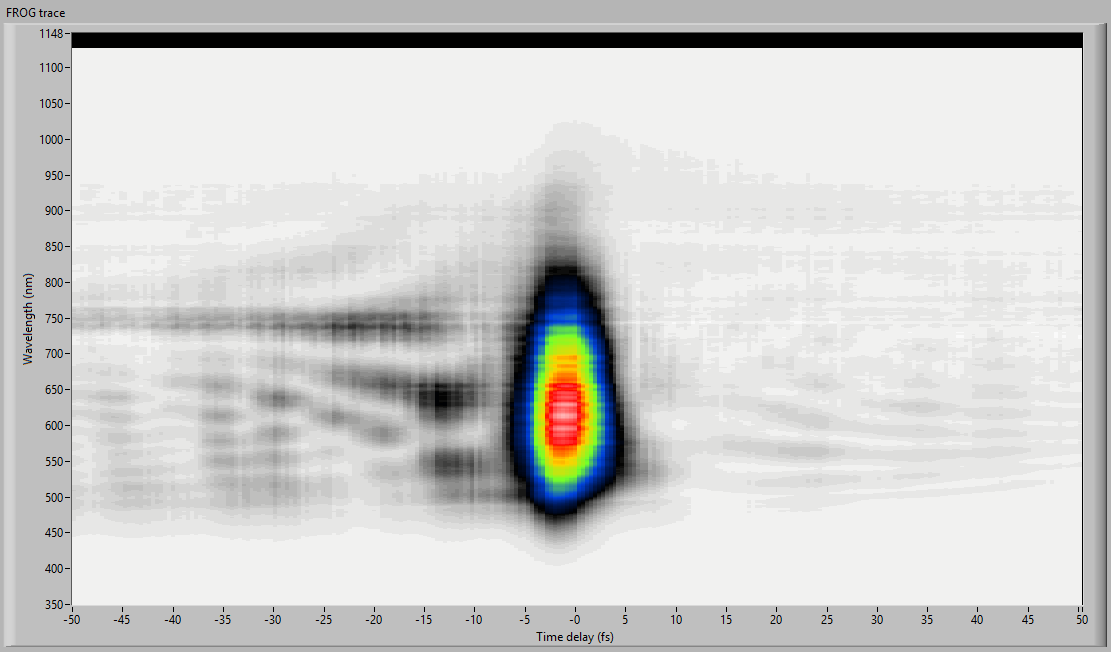
Performance.
Limitless.
On left is the screenshot of the actual Frequency-Resolved Optical Gating (FROG) trace recorded from the LabVIEW VI. No smoothing has been applied. The spectra are already wavelength and intensity calibrated. The reconstructed pulse duration is 4.9 fs.
Extreme Performance!
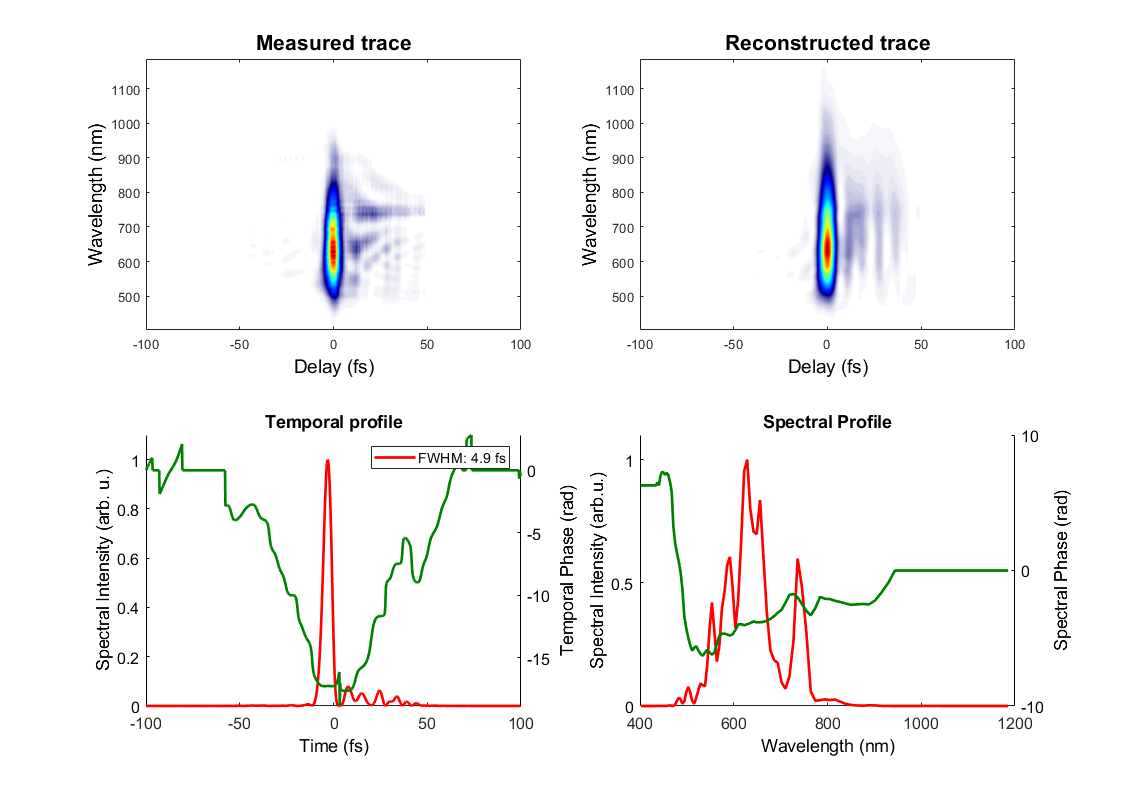
Pulse duration: no limit*
Our FROG can measure 5fs to 300fs (up to 2 ps with one trick). The only limit to the pulse duration measurement with our FROG is the spectral range covered by the given model of your selection.
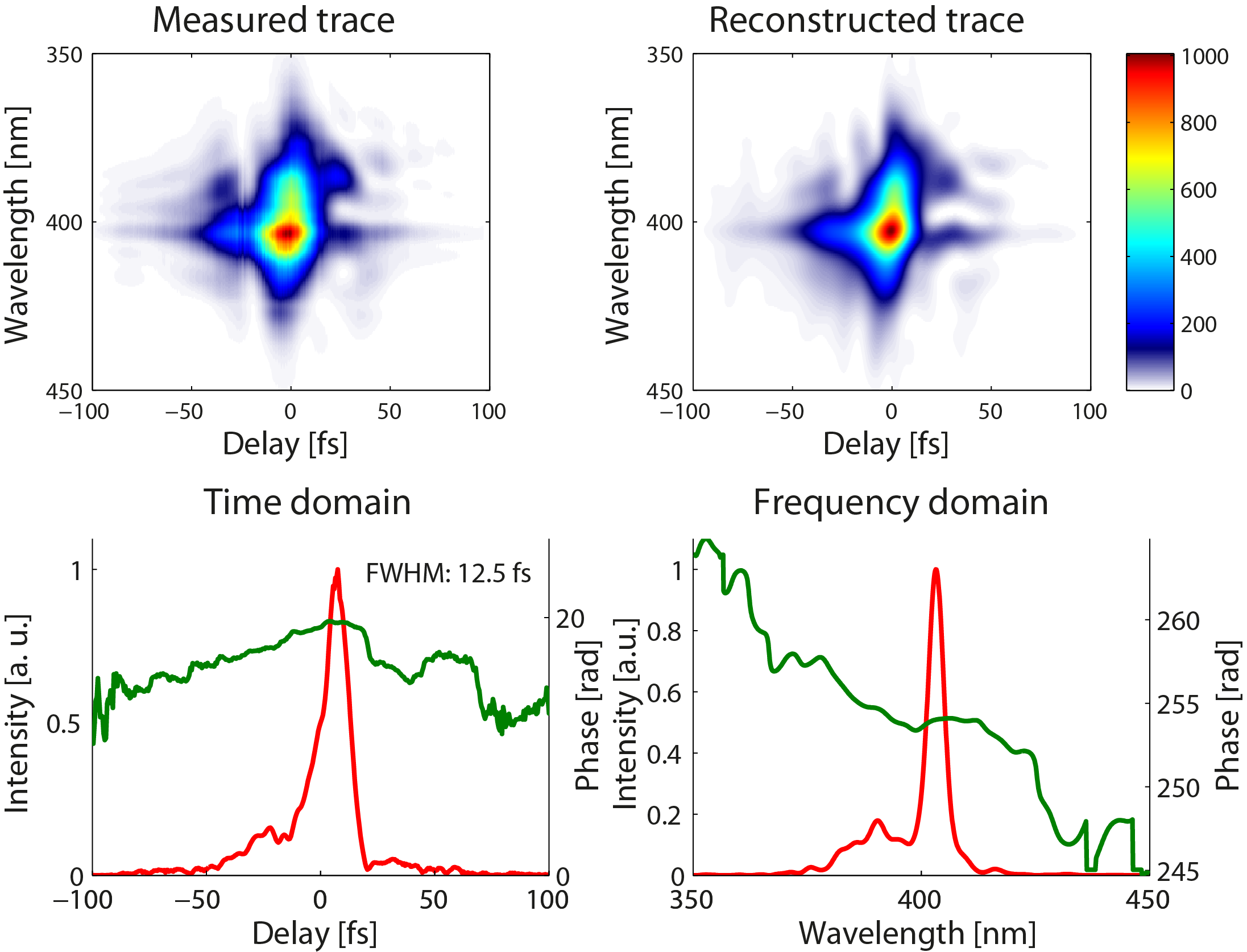
Center wavelength: no limit*
The spectrometer has its limits, so those limits are actually the bottleneck of our FROG.
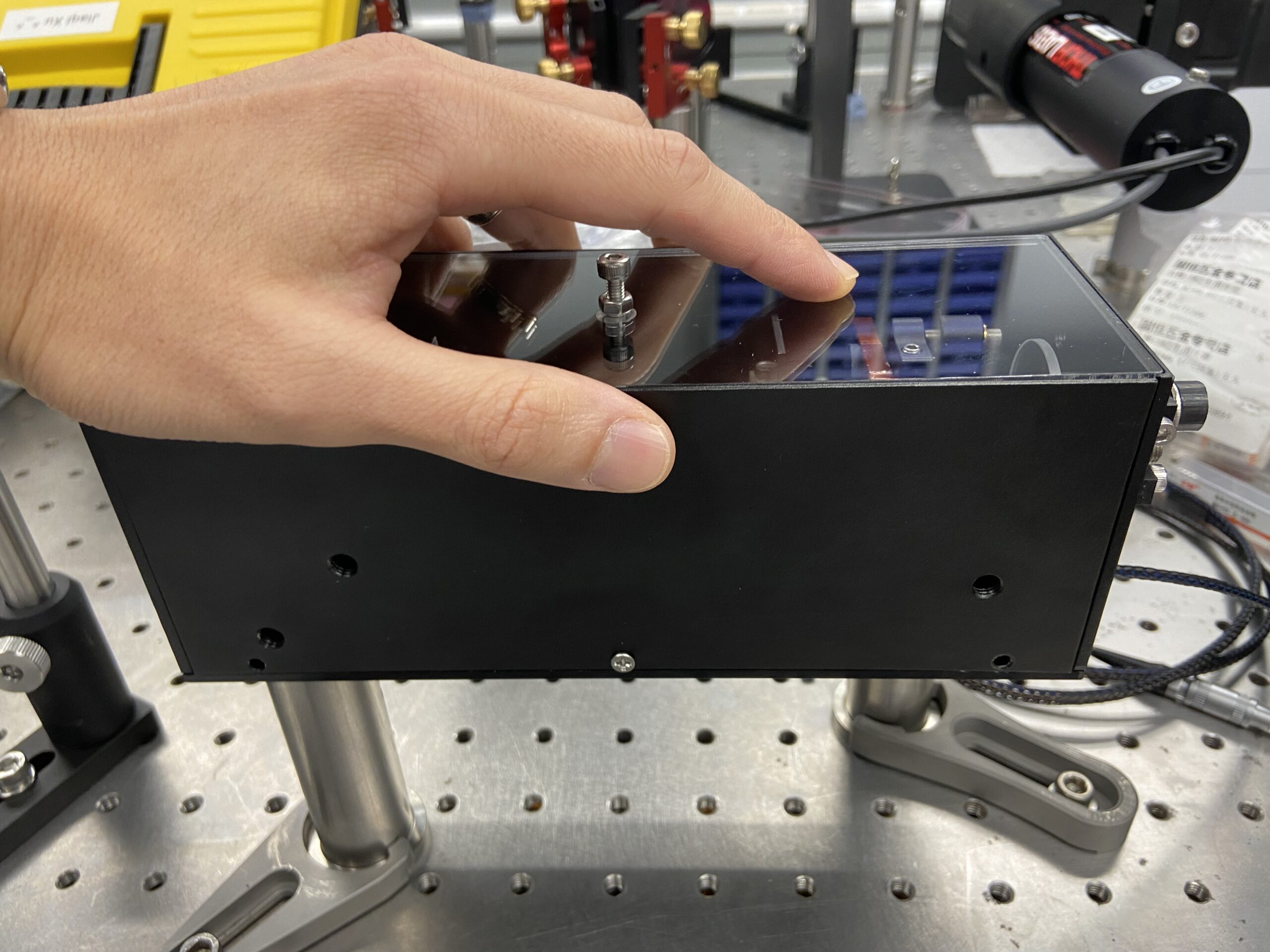
Convenient: absolute!
Provided that the alignment is good and pulse energy is sufficient, you can switch between a measurement at 5 fs pulse measurement at center wavelength of 650 nm and a 100 fs pulse measurement at center wavelength of 266 nm, or a measurement of 200 fs pulse at 900 nm by just a flip of a mirror. This mirror flipping is only to route your beam to the FROG. There is nothing needed to be changed internally inside the FROG.
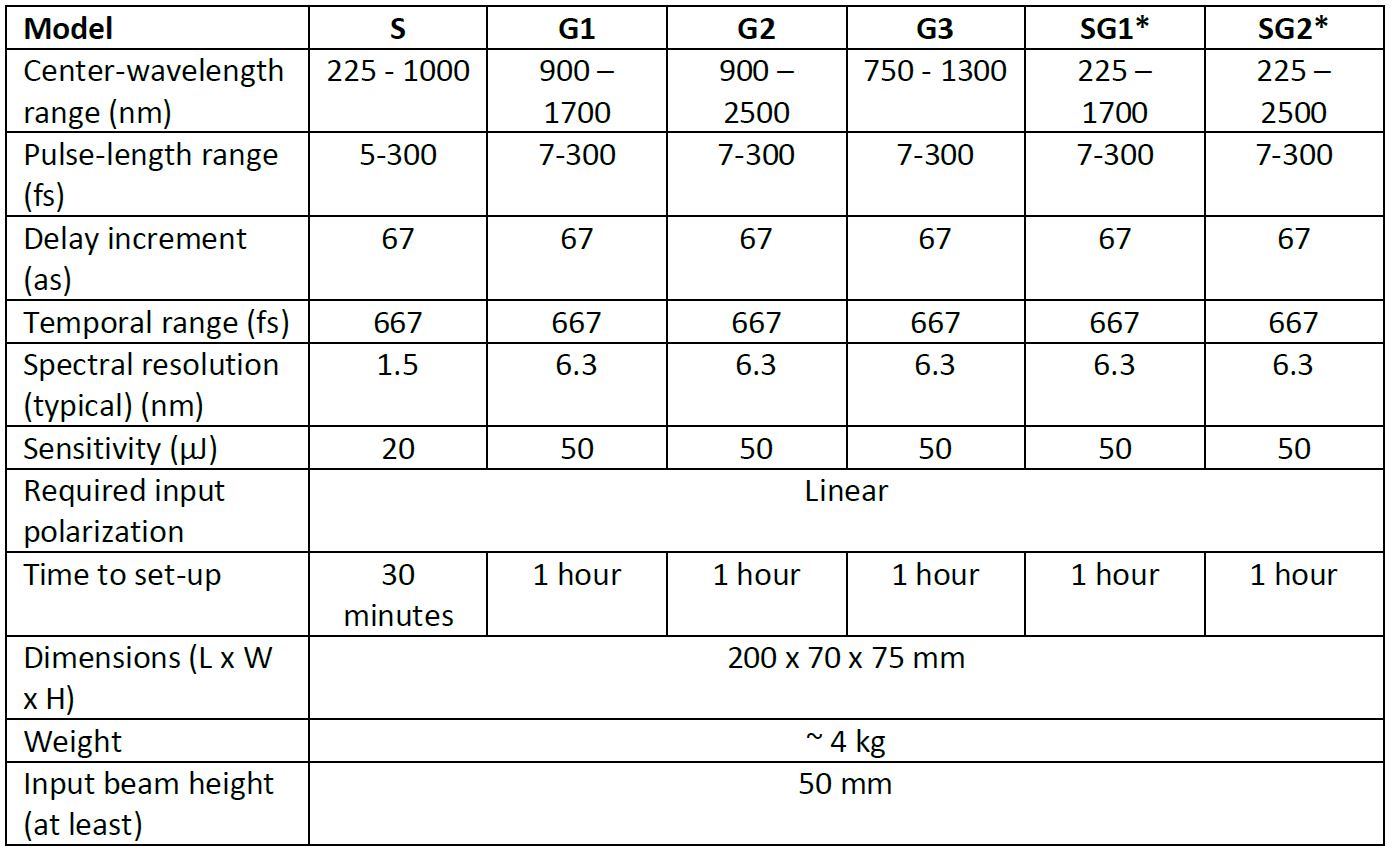
Standard models are shown on left
SG1 and SG2 are models with two (02) spectrometers. The InGaAs sensors are TE-cooled.
Customers interested in customized model(s), please kindly contact us!
Frequently
Asked
Questions
Is the spectrometer included in the box?
Yes, the spectrometer is both wavelength AND intensity calibrated and it is configured to run in the FROG mode or standalone mode. In other words, customers can actually use our spectrometer just to measure spectra that they like, regardless of whether they want to do FROG or not.
If it can measure any pulse at any center wavelength, what are the differences between models S, G1, and G2?
The only difference is that different models come with different spectrometers (and a bit of difference internally, but this is really tiny difference). For example, if you select model S, then you can measure a 5 fs pulse with spectral range covering 225 nm to 600 nm, for example; or you can measure 100 fs pulse with center wavelength at 800 nm (likely 790 nm to 810 nm) or 50 fs pulse with center wavelength at 400 nm (likely 390 nm to 410 nm), etc.
If I have a CCD with different grating options, can I measure across that full range?
No. The reason is that the sensitivity of the sensor differs vastly from visible domain to infrared domain. If the customers want to measure any pulse whose spectral range is falling from 225-1000 nm, then he/she should choose model S. Similarly for model G1 and G2. These two models are significantly more expensive though.
Is there a scanning stage involved here or is there a different interferometric approach?
Yes, the scanning stage is involved. We have one of the best piezo stages in the industry for this FROG. Most of the components or optics we used are the best in the market. We do not compromise on the performance.
What is the alignment sensitivity? (Can you quantify?)
Yes, for model S, the lowest pulse energy that we tested is 10 uJ. And for model G1, G2, we tested and figured out that 50 uJ is the limit. However, we would recommend the customer to arrange higher energy to make measurement easier. For alignment purpose, we have two irises inside the device, so it would be easy alignment, just to make sure the incoming beam go through two irises properly.
How is the screenshot of the FROG trace obtained? Is there a software package provided?
Yes, we wrote this measurement software completely ourselves. The software is a complete LabVIEW VI that do all the control and recording. The screenshot is saved automatically every time you click “save”. It will save a screenshot of the trace on the LabVIEW panel so that it helps to know roughly what the FROG trace looks like. If you want to do detailed analysis and reconstruction, then the binary data can be used. The reconstruction software is also provided. The software, laptop, spectrometer, and FROG device itself will be included in the shipping box. We additionally include the Matlab script for plotting the results as an extra feature.
Is the picture you provided the full footprint of the device (minus the spectrometer)?
Yes, you are absolutely right! Minus the mini spectrometer (size of a credit card), the controller of the FROG, and the laptop. They are connected to the FROG by the wires/optical cable but you can put all of these on the shelf and move the FROG device any where on the table.
Are there beam size limitations?
Yes, the beam should have the diameter no smaller than 5 mm and not much larger than 15 mm.
Do you expect to create a standard product offering, or is this a highly customized product?
This is a standard product. However, we can make tailored products depending on customer’s request.
What support do you provide during setup? Do you customers setup the device themselves or does this require a site visit?
Each device will be tested to be fully functioning and should be running out of the box with complete hardware and software included. Theoretically, the customers will only need to turn on the device, laptop, align the beam a little bit and then click run. However, in reality, we will provide Zoom or TeamViewer support for customer during the installation and training. We have an obligation to provide quick (first reply within 24 hours) and reliable support (via Zoom or Team Viewer) for the customers.
